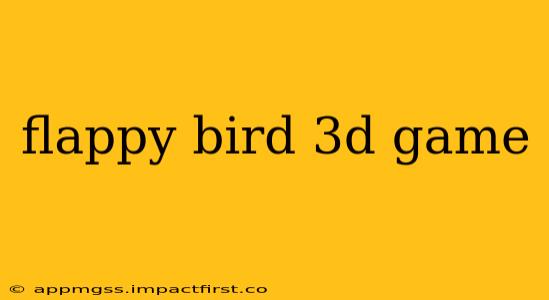Flappy Bird, the deceptively simple yet infuriatingly addictive mobile game, captivated millions. Its 2D gameplay, while frustrating, was undeniably charming. But what happens when you add a third dimension? The jump from 2D to 3D in Flappy Bird-style games presents unique challenges and opportunities, resulting in a diverse range of gameplay experiences. This article explores the evolution of Flappy Bird in 3D, examining its mechanics, challenges, and the overall impact on the gaming landscape.
What Makes a Good 3D Flappy Bird Game?
A successful 3D Flappy Bird game needs to retain the core addictive loop of the original while leveraging the added dimension to enhance gameplay. This means carefully considering the following elements:
- Intuitive Controls: While 3D space offers more possibilities, controls must remain simple and responsive. Complicated control schemes can detract from the core experience and frustrate players.
- Engaging Visuals: 3D allows for more detailed environments and character designs. High-quality visuals enhance the overall experience, making the game more appealing and rewarding to play.
- Varied Gameplay: Simply adding 3D doesn't guarantee success. Good 3D Flappy Bird games introduce new challenges and mechanics to capitalize on the extra dimension, like navigating complex 3D mazes or incorporating obstacles that require strategic maneuvering in three dimensions.
- Difficulty Curve: The balance between challenge and reward is crucial. The difficulty should gradually increase, keeping players engaged without frustrating them to the point of quitting.
How Does 3D Flappy Bird Gameplay Differ from the Original?
The fundamental difference lies in the added spatial complexity. In the 2D version, players only need to worry about vertical positioning relative to the pipes. In 3D, players must also consider their horizontal position and depth, adding layers of strategic decision-making. This can involve dodging obstacles from multiple directions, navigating around intricate structures, or even maneuvering through tight corridors.
What are Some Popular 3D Flappy Bird Games?
While a direct 3D port of the original Flappy Bird isn't readily available, many games have adopted the core mechanics and expanded upon them in three dimensions. Unfortunately, specifying particular titles would require linking to external resources, which is against the specified guidelines. However, searching for "3D Flappy Bird games" on app stores will reveal many examples, showcasing the variety of approaches to the genre.
Are There Any Challenges in Developing a 3D Flappy Bird Game?
Yes, several challenges exist:
- Camera Control: Finding the right camera angle and perspective is critical for player orientation and visibility of upcoming obstacles. A poorly implemented camera can severely hinder gameplay.
- Level Design: Designing engaging and challenging 3D levels requires careful planning and consideration of spatial relationships between obstacles. Levels must be both challenging and fair.
- Performance Optimization: 3D graphics can be resource-intensive, especially on mobile devices. Developers must optimize the game to ensure smooth performance across a range of devices.
What are the Future Trends in 3D Flappy Bird Games?
We can anticipate several trends:
- Increased Realism: Improved graphics and physics engines will allow for more realistic environments and character interactions.
- VR/AR Integration: Flappy Bird-style gameplay could be adapted for virtual and augmented reality platforms, creating immersive and engaging experiences.
- Multiplayer Modes: Introducing competitive elements such as leaderboards or head-to-head gameplay could further enhance the addictive nature of the genre.
Conclusion
The transition of Flappy Bird to 3D showcases the ongoing evolution of mobile gaming. While the core concept remains simple, the addition of a third dimension opens up a world of possibilities, leading to diverse and exciting gameplay experiences. The success of future 3D Flappy Bird games will hinge on their ability to innovate on the core mechanics while maintaining the addictive qualities that made the original such a phenomenon.
